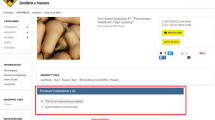Abstract
Modern WWW methodologies focus on developing context-aware data delivery applications on the Web, but very few proposals provide a conceptual modeling of their adaptation specifications. In this paper, we present AML—Adaptation Modeling Language—to specify complex Adaptive Web Applications at the conceptual level. AML models the adaptation process by using a special workflow involving modeling primitives that execute elementary manipulations. The adaptation considers different and orthogonal components of the context and operates over the selection of the most suitable contents, the organization of the hypertext structure of the response, and the layout of the final pages. The language and its design process are fully implemented in a CASE tool, called FAWIS. Specifically, FAWIS is able to access a Web data source and automatically filter and adapt information delivery on the basis of the context of the client. The tool is able to manage heterogeneous contexts, is easy extensible to new coordinates of adaptation, and can integrate different adaptation requirements solving possible conflicts between them. It allows the designer to define the response that better satisfies the requirements of adaptation for a context.


















Similar content being viewed by others
References
Atzeni P, Merialdo P, Mecca G (2001) Data-intensive web sites: design and maintenance. World Wide Web J 4(12):2147
Bettini C, Maggiorini D, Riboni D (2005) Distributed context monitoring for continuous mobile services. In: Proceedings of working conference on mobile information systems (MOBIS05). Leeds, UK
Bolchini C, Curino C, Schreiber FA, Tanca L (2006) Context integration for mobile data tailoring. In: Proceedings of 7th International conference on mobile data management (MDM06), Nara, Japan
Cachero C, Gomez J, Pastor O (2001) Object-oriented conceptual modeling of web application interfaces: the OO-HMethod presentation abstract model. In: Proceedings of 6th international conference on E-Commerce and web technologies (EC-Web01), Munich, Germany
Ceri S, Daniel F, Demald V, Facca FM (2005) An approach to user-behavior-aware web applications. In: Proceedings of 5th International conference on web engineering (ICWE05). Springer, Sydney
Ceri S, Daniel F, Matera M, Facca FM (2007) Model-driven development of context-aware Web applications. In: ACM transactions of internet technology, vol 7, issue no 1. ACM Publisher, New York
Ceri S, Fraternali P, Bongio A, Brambilla M, Comai S, Matera M (2003) Designing data-intensive web applications. Morgan Kaufmann Publ Inc, San Francisco
De Virgilio R, Torlone R, Houben GJ (2007) Rule based adaptation of web information systems. World Wide Web J 10(4):443–470
De Virgilio R, Torlone R (2008) A framework for the management of context data in adaptive web information systems. In: 8th International conference on web engineering (ICWE’08)
De Virgilio R, Torlone R (2008) A meta-model approach to the management of hypertexts in web information systems. In: 5th International workshop on web information systems modeling (WISM’08)
De Virgilio R, Torlone R, Valeriano D, Di Federico D (2007) A Cluster-based approach to web adaptation in context-aware applications. Int J Web Eng 6(4):360–388
Fiala Z, Hinz M, Meissner K, Wehner F (2003) A component-based approach for adaptive dynamic web documents. J Web Eng 2(12):5873
Isakowitz T, Stohr EA, Balasubramanian P (1995) RMM: a methodology for structured hypermedia design. Commun ACM 38(8):3444
Kappel G, Retschitzegger W, Schwinger W (2001) Modeling ubiquitous web applications: the WUML approach. In: International workshop on data semantics in web information systems (DASWIS01), Yokohama, Japan
Kiyomitsu H, Takeuchi A, Tanaka K (2001) Activeweb: xml-based active rules for web view derivations and access control. In: International workshop on information technology for virtual enterprises (ITVE01), Queensland, Australia
Pelechano V, Fons J, Albert M, Pastor O (2003) Developing web applications from conceptual models. In: Proceedings of 15th conference on advanced information systems engineering (CAISE03). Klagenfurt, Austria
Schwabe D, de Almeida Pontes R, Moura I (1999) OOHDM-Web: an environment for implementation of hypermedia applications in the WWW. ACM SIGWEB Newslett 8(2):1834
Schwabe D, Rossi G, Barbarosa SDJ (1996) Systematic hypermedia application design with OOHDM. In: Proceedings of 7th ACM Conference on Hypertext (HYPERTEXT96), Washington, USA
UWA Consortium (2002) The UWA approach to modeling ubiquitous web applications. In: Proceedings of IST mobile and wireless telecommunications summit, Thessaloniki, Greece
Vdovjak R, Fransincar F, Houben GJ, Barna P (2003) Engineering semantic web information systems in Hera. J Web Eng 2(12):326
Author information
Authors and Affiliations
Corresponding author
Rights and permissions
About this article
Cite this article
De Virgilio, R. AML: a modeling language for designing adaptive web applications. Pers Ubiquit Comput 16, 527–541 (2012). https://doi.org/10.1007/s00779-011-0418-9
Received:
Accepted:
Published:
Issue Date:
DOI: https://doi.org/10.1007/s00779-011-0418-9




